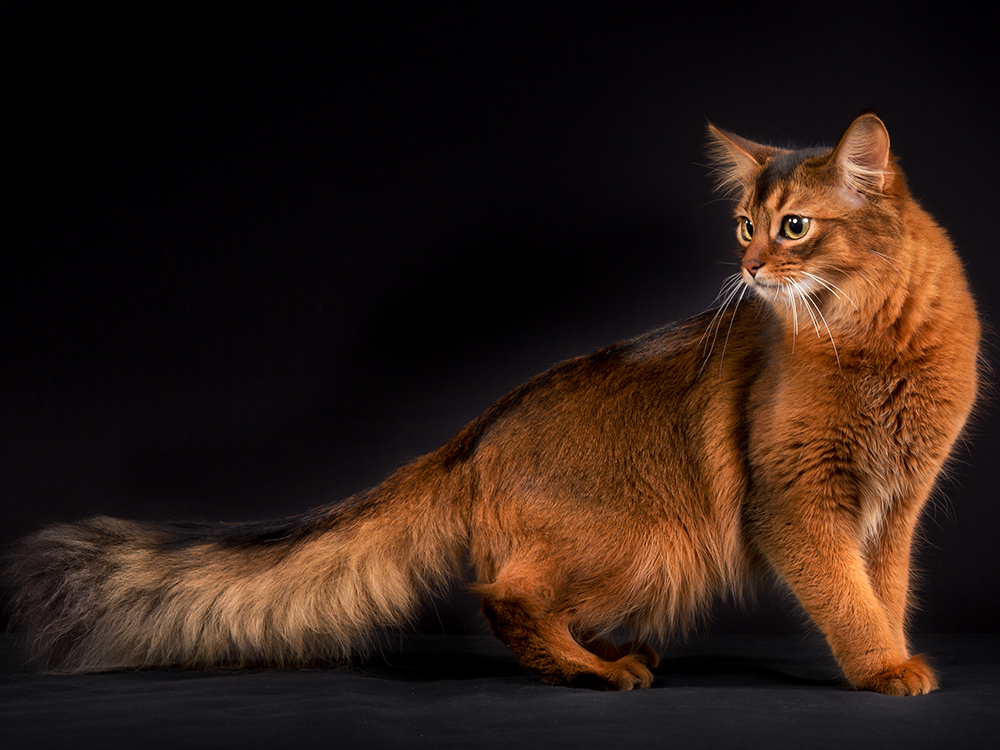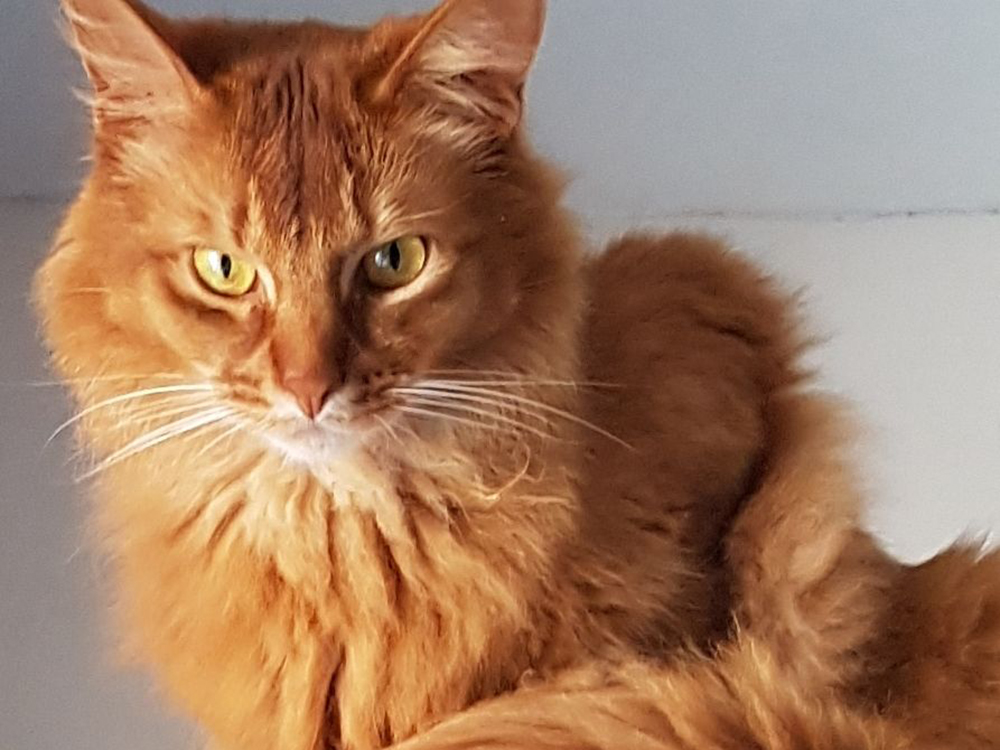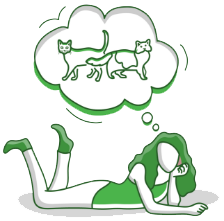
Somali Breed Pictures
Vital Breed Stats
| Weight: | 3 - 5 kg M | 3 - 5 kg F |
| Life Expectancy: | 12 - 15 years |
Breed Characteristics
| Size: |  |
| Grooming: |  |
| Good with Children: |  |
| Good with other pets: |  |
| Affectionate: |  |
| Active Level: |  |
Give a thumbs up if you love the Somali

0
More About the Breed
History
There have been arguments on the emergence of the Somali cats. It was believed to be one of the ancient breeds, having been depicted it a papyrus art that dates back to 900 BC.
The Somali cat is an Abyssinian longhaired variety. Longhaired kittens of Abyssinian ancestry were considered undesirable, thus, they were not recorded. However, an American breeder, Evelyn Mague, acknowledged the potential of a new breeding programme using these longhaired kittens. She took a longhaired Abyssinian kitten, George, from a cat shelter where she was a volunteer. Mague was successful in initiating the mating with an outcome of another longhaired female kitten in 1972. She was the one who gave the name Somali to the new breed. Contrary to its name, the Somali cat is actually not from Somalia, the neighbouring country of Abyssinia (known nowadays as Ethiopia). Mague gave the said name in honour of its closeness with the Abyssinian cousins.
Through the years, the Abyssinian was the main breed used for further strengthening the breed’s gene pool. The Siamese, Burmese, and Russian Blues are also occasionally used to serve the same purpose.
Nowadays, the Somali cat breed is a recognised breed in cat registries including the Cat Fanciers’ Association (CFA) since 1979. Furthermore, it earned the Governing Council of the Cat Fancy’s (GCCF) recognition in 2011 and a Championship status in 2014.
Appearance and Grooming
The Somali cat is well-balanced feline with a medium body build that can either have short or semi-longhaired coats. The body is firm and muscular and in proportion with its long legs and oval-shaped paws. It has a moderately wedged head. The face profile boasts a gentle smiling look with a firm chin. The ears are set widely, broad at the base and are proportionately large with long hair on the inner edges.
It has large almond-shaped eyes. They are set proportionately apart completing an expressive look. Eye colour can be the following: amber, hazel or green. The desired colour is rich and deep shades.
One of its striking features is its bushy tail that gives the look of a fox. For a longhaired Somali cat, the tail’s base is broad that slightly tapers to a full brush whilst the shorthaired has a rounded tip.
As for its coat, it can either be short or semi-longhaired with well-defined ticking, the defining characteristic of the breed. There are at least three bands of ticking shades on every hair. It is expected to develop gradually but should still be visible on the shoulders of all kittens in at least 12 weeks old. The pattern is of the same colour on its ear tips and tufts, facial markings, toe tufts, and the top and tip of the tail. Having a darker shade along the spine and top of the tail is a desired feature.
Moreover, the semi-longhaired feline’s coat lies flat along its spine whilst the shorthaired have a smooth coat closely lying on its skin. The coat is fine and dense in texture. The following are the Somali cat colours:
- Blue
- Cream
- Chocolate
- Fawn
- Lilac
- Red
- Sorrel
- Usual
- Blue Tortie
- Chocolate Tortie
- Fawn Tortie
- Lilac Tortie
- Sorrel Tortie
- Usual Tortie
- Blue Silver
- Cream Silver
- Chocolate Silver
- Fawn Silver
- Lilac Silver
- Red Silver
- Sorrel Silver
- Usual Silver
- Blue Tortie Silver
- Chocolate Tortie Silver
- Fawn Tortie Silver
- Lilac Tortie Silver
- Sorrel Tortie Silver
- Usual Tortie Silver
Temperament and Intelligence
Similar to its Abyssinian cousins, the Somali cats are highly intelligent and naturally inquisitive that would relish a good time exploring its surroundings. It should be provided with a secure garden or a close monitoring so it will not wander off. It can adapt well as an indoor pet when provided with plenty of toys and things that will keep it entertained. Scratching posts and good climbing posts would keep it busy.
The Somali cat personality makes it an ideal cat for people who are looking for affectionate and interactive felines. It is a wonderful companion that enjoys involvement in the activity of the owner. As much as it is interactive and playful, it can very well alter its characteristic to a very affectionate one. At times, it seeks affection as a lap cat or a cuddle buddy under the covers, just as long as it is in the company of its owners.
Further, it may be friendly but not to other cats where it needs to share attention. It is best suited for a family with older children where it already knows how to handle cats with great care.
Nutrition and Feeding
The Somali breed should be provided with a nutritious diet that fulfils its nutritional needs. It should be consistently given the same food following the same feeding schedule. If there are changes to its diet, those must be done gradually to prevent digestive problems.
The serving portions mainly depend on the cat’s weight, age, and activity level. Its diet must include at least 25% protein and just 5% carbohydrates.
Health and Exercise
On average, the Somali’s life expectancy ranges from 12 and 14 years. This cat breed is among the healthiest and is known to be affected only by a few hereditary health issues.
However, there have been cases of Somali cats affected by Pyruvate kinase deficiency. As such, it is necessary to check the Somali breeders’ credentials before acquiring one.
Further, ensure that this feline gets enough exercise and its diet managed well to prevent it from becoming obese. Being an intelligent breed, it should be provided with toys and activities that will also challenge its mental abilities.
Cost of Ownership
A pedigreed Somali kitten will cost £400 or higher. Average insurance expenses would cost £15 (basic) to £25 (lifetime) monthly. Food costs may range from £15-£20 each month. For vaccinations, boosters, annual checks and other veterinary costs, pet care costs may add up to more than £600 each year.
On average, a Russian cat owner will spend about £15-£20 per month. The insurance costs can also affect this estimate. For its entire lifetime (12-14 years), the expenses can be as low as £2,160 to as high as £3,360 overall. This estimate does not include the initial costs incurred in acquiring this cat.
Is a Somali Right for You?
- It can either be a lap cat or a good outdoor partner.
- It requires more grooming compared to other breeds.
- It is not the best choice for people with cat allergies.
- It is a naturally inquisitive cat that will most likely explore outdoors on its own.









